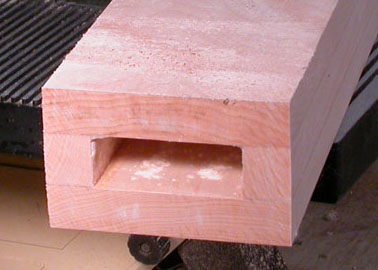I built this block back in early spring and blogged about building it here. As you may recall, I called it the Mark III because it was the third version of a block cut from glued up maple stock. This block represented the culmination of a heck of a lot of work, and I was darn proud of it.
As reported, I put it into service as my main sheet block. As such, it was shackled to a pad eye on the bridge deck of the Blue Moon. It was more or less constantly exposed to the sun and elements, but because of it's position on deck, it never simply sat in water. If it got rained on, it dried out swiftly as soon as the sun came out.
I did not varnish the maple, just gave it the linseed oil bath much recommended on the Wooden Boat Forum.
For awhile, it looked pretty good.
 |
| Brand new block |
 |
| After one summer in the sun and rain |
 |
| Failed glue joint |
Actually, the failed joint came as no surprise. As I've mentioned since building this block, I've been studying basic woodworking, including basic joinery. This joint breaks one of the cardinal rules of glue joints: never glue to end grain.
If you study the direction of the grain in the original glued up blank, you can see that the spacers -- the small strips of wood between the larger cheeks -- are glued on their end grain. They should have been turned 90 degrees, so the glue joint would have been long grain to long grain.
Ah well. Luckily I figured this out before I started building my Mark IV oak blocks, so I was more or less expecting the joints to fail, sooner or later. The fact that they failed within one summer shows how important it is to get the joints right.
 |
| Spacers are glued on end grain |
The remaining mystery was, why did the maple block grow such a good crop of mildew, when the oak blocks didn't?
The photo below was taken after a summer of use in much the same environment. It looks very much the same as it did when it was brand new.
The oak block had the same linseed oil finish, and the same rope strop. What was the difference?
 |
| No mildew on the Mark IV oak block |
I asked this question on the Wooden Boat Forum, and David from Harbor Woodworks in Portland, OR was kind enough to answer it.
The answer is that maple wood contains too much food (sugar, probably) for fungus to resist. With heat and a bit of moisture, they flock to the dinner table like deadbeat relatives at Thanksgiving.
Other woods, such as teak, mahogany, black locust, cherry, walnut, white oak, sapele, and khaya don't have this problem. Which explains why the oak blocks remained mildew free.
So, if the value of a project can be measured by lessons learned, I have to count my Mark III block project as a complete success!
So many lessons... so little time!
>>> Next Episode: Winter Cover
Great post. Thanks for the lessons!
ReplyDelete